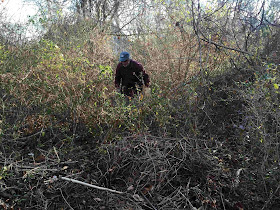By Beth Sullivan
Not rain, nor snow nor sleet or hail: nothing can stop the Audubon Christmas Bird Count. Well, almost nothing. One year there was a blizzard and it was reluctantly rescheduled. Not because folks were worried about driving about in the weather, but because visibility would be low and they might not get to see many birds and thus lower their tallies.
 |
| Bluebirds(above) and Robins often remain through the winter when there are berries available. |
For 117 years birders around North America have joined forces to be citizen scientists on behalf of collecting data and increasing our knowledge and understanding about birds in a given area. By being consistent with the dates: always between December 14 and January 5, and consistent with the areas covered each year, data has been collected and studied to give ornithologists a better view of changes in populations of birds over time.
The New London Circle
The New London Bird Count was started in the 1940's. It is based on a circle centered at the intersection of Gardner and Ocean Avenues in New London. The circles are all 15 miles in diameter and are often created to include the greatest diversity of habitats, thereby increasing the greatest number of species possible.
 |
| Buffleheads(above) and Hooded Mergansers are found in many quiet coves along the shoreline. |
If you look on Google Maps for Christmas Bird Counts, you can see our area covered by the circle. It extends to include Rocky Neck in the West to Mason’s Island in the East. To the North it goes up the Thames River to Bartlett’s Cove in Montville and at its Southern most reach it includes the Western 2/3 of Fisher’s Island and includes the Island owned by Avalonia: South Dumpling. All of Avalonia’s Preserves in Groton are included, some from Stonington and a bit of Ledyard as well.
 |
| Our local CBC circle |
Checking out all the hot spots
It includes just about every habitat possible: hardwood forests, shrub-land, fields and meadows, freshwater wetlands and reservoirs, brackish tidal areas, salt marshes, open water of the Long Island Sound, rocky islands and sandy shores. Much of the land covered is public land, but private landowners contribute observations and open their properties for the count as well. The area is covered by teams of birders who will move from place to place during the course of the day. Some start before dawn to find the owls as they roost. Many of these teams have been doing the count for decades and know the “hot spots” and come to expect certain species in certain areas. One team may hop the Ferry from New London to Fisher’s Island just to get a count of those open water birds that are rarely found close to shore. |
| Mallards are the ducks with the overall highest counts every year. |
Bob Dewire has been organizing and doing compilation for the New London Christmas Count for more than 50 years. His teams will be spreading out on December 31. A good year will see the tally around 120 species.
 |
| Several species will converge where the water is ice free. |
Check the National Audubon CBC website for a lot more history and information. Then register to be part of the count and get out on Saturday, December 31. Don’t forget the binoculars Santa brought and a note pad. Have some fun and Merry Christmas to all.
 |
| Song Sparrows hide in brush piles and find seeds in meadows. |
Photographs by Beth Sullivan and Rick Newton.






















